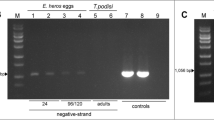Abstract
In this report we describe for the first time the detection of Sarcoptes scabiei type suis mites on domestic pigs in Israel and examine its genetic variation compared with S. sabiei from other hosts. Microscopic examination of skin samples from S. scabiei-infested pigs (Sus scrofa domesticus) revealed all developmental stages of S. scabiei. To detect genetic differences between S. scabiei from different hosts, samples obtained from pig, rabbits (Orictolagus cuniculus), fox (Vulpes vulpes), jackal (Canis aureus) and hedgehog (Erinaceus concolor) were compared with GenBank-annotated sequences of three genetic markers. Segments from the following genes were examined: cytochrome C oxidase subunit 1 (COX1), glutathione-S-transferase 1 (GST1), and voltage-sensitive sodium channel (VSSC). COX1 analysis did not show correlation between host preference and genetic identity. However, GST1 and VSSC had a higher percentage of identical sites within S. scabiei type suis sequences, compared with samples from other hosts. Taking into account the limited numbers of GST1 and VSSC sequences available for comparison, this high similarity between sequences of geographically-distant, but host-related populations, may suggest that different host preference is at least partially correlated with genetic differences. This finding may help in future studies of the factors that drive host preferences in this parasite.


Similar content being viewed by others
References
Alasaad S, Soglia D, Spalenza V, Maione S, Soriguer RC, Pérez JM, Rasero R, Degiorgis MP, Nimmervoll H, Zhu XQ, Rossi L (2009) Is ITS-2 rDNA suitable marker for genetic characterization of Sarcoptes mites from different wild animals in different geographic areas? Vet Parasitol 159:181–185
Amer S, El Wahab TA, Metwaly Ael N, Ye J, Roellig D, Feng Y, Xiao L (2014) Preliminary molecular characterizations of Sarcoptes scaibiei (Acari: Sarcoptidae) from farm animals in Egypt. Plos One 9:e94705
Arlian LG, Runyan RA, Estes SA (1984) Cross infestivity of Sarcoptes scabiei. J Am Acad Dermatol 10:979–986
Bornstein S, Zakrisson G (1993) Clinical picture and antibody response in pigs infected by Sarcoptes scabiei var. suis. Vet Dermatol 4:123–131
Dougall A, Holt DC, Fischer K, Currie BJ, Kemp DJ, Walton SF (2005) Identification and implication as a potential major allergen in crusted scabies. Am J Trop Med Hyg 73:977–984
Edgar RC (2004) MUSCLE: multiple sequence alignment with high accuracy and high throughput. Nucleic Acids Res 32:1792–1797
Fain A (1978) Epidemiological problems of scabies. Int J Dermatol 17(1):20–30
Greves JH, Davies P (2012) External parasites. In: Zimmerman JJ, Karriker LA, Ramirez A, Schwartz KJ, Stevenson GW (eds) Diseases of swine, 10th edn. Wiley, Ames, pp 885–894
Klompen JSH (1992) Phylogenetic relationships in the mite family Sarcoptidae (ACARI: Astigmata). University of Michigan, Museum of Zoology, pp 34–35
Makouloutou P, Suzuki K, Yokoyama M, Takeuchi M, Yanagida T, Sato HJ (2015) Involvement of two genetic lineages of Sarcoptes scabiei mites in a local mange epizootic of wild mammals in Japan. Wildl Dis 51:69–78
Mullen GR, OConnor BM (2002) Mites (Acari). In: Mullen GR, Durden LA (eds) Medical and veterinary entomology, 1st edn. Academic Press, San Diego, pp 464–492
Pasay C, Walton S, Fischer K, Holt D, McCarthy J (2006) PCR-based assay to survey for knockdown resistance to pyrethroid acaricides in human scabies mites (Sarcoptes scabiei var hominis). Am J Trop Med Hyg 74:649–657
Pasay C, Arlian L, Morgan M, Vyszenski-Moher D, Rose A, Holt D, Walton S, McCarthy J (2008) High-resolution melt analysis for the detection of a mutation associated with permethrin resistance in a population of scabies mites. Med Vet Entomol 22:82–88
Pettersson EU, Ljunggren EL, Morrison DA, Mattsson JG (2005) Functional analysis and localisation of a delta-class glutathione S-transferase from Sarcoptes scabiei. Int J Parasitol 35:39–48
Skerratt LF, Campbell NJ, Murrell A, Walton S, Kemp D, Barker SC (2002) The mitochondrial 12S gene is a suitable marker of populations of Sarcoptes scabiei from wombats, dogs and humans in Australia. Parasitol Res 88:376–379
Tamura K, Nei M (1993) Estimation of the number of nucleotide substitutions in the control 447 region of mitochondrial DNA in humans and chimpanzees. Mol Biol Evol 10:512–526
Tamura K, Stecher G, Peterson D, Filipski A, Kumar S (2013) MEGA6: molecular evolutionary genetics analysis version 6.0. Mol Biol Evol 30(12):2725–2729
Walton SF, Currie BJ, Kemp DJ (1997) A DNA fingerprinting system for the ectoparasite Sarcoptes scabiei. Mol Biochem Parasitol 85:187–196
Walton SF, Choy JL, Bonson A, Valle A, McBroom J, Taplin D, Arlian L, Mathews JD, Currie B, Kemp DJ (1999) Genetically distinct dog-derived and human-derived Sarcoptes scabiei in scabies-endemic communities in northern Australia. Am J Trop Med Hyg 61:542–547
Walton SF, Dougall A, Pizzutto S, Holt D, Taplin D, Arlian LG, Morgan M, Currie BJ, Kemp DJ (2004) Genetic epidemiology of Sarcoptes scabiei (Acari: Sarcoptidae) in northern Australia. Int J Parasitol 34:839–849
Yeruham I, Rosen S, Hadani A, Nyska A (1996) Sarcoptic mange in wild ruminants in zoological gardens in Israel. J Wildl Dis 32:57–61
Yeruham I, Rosen S, Hadani A, Braverman Y (1999) Arthropod parasites of Nubian ibexes (Capra ibex nubiana) and gazelles (Gazella gazella) in Israel. Vet Parasitol 83:167–173
Zhao Y, Cao Z, Cheng J, Hu L, Ma J, Yang Y, Wang X, Zeng J, Wang T (2015) Population identification of Sarcoptes hominis and Sarcoptes canis in China using DNA sequences. Parasitol Res 114:1001–1010
Author information
Authors and Affiliations
Corresponding author
Rights and permissions
About this article
Cite this article
Erster, O., Roth, A., Pozzi, P.S. et al. First detection of Sarcoptes scabiei from domesticated pig (Sus scrofa) and genetic characterization of S. scabiei from pet, farm and wild hosts in Israel. Exp Appl Acarol 66, 605–612 (2015). https://doi.org/10.1007/s10493-015-9926-z
Received:
Accepted:
Published:
Issue Date:
DOI: https://doi.org/10.1007/s10493-015-9926-z




